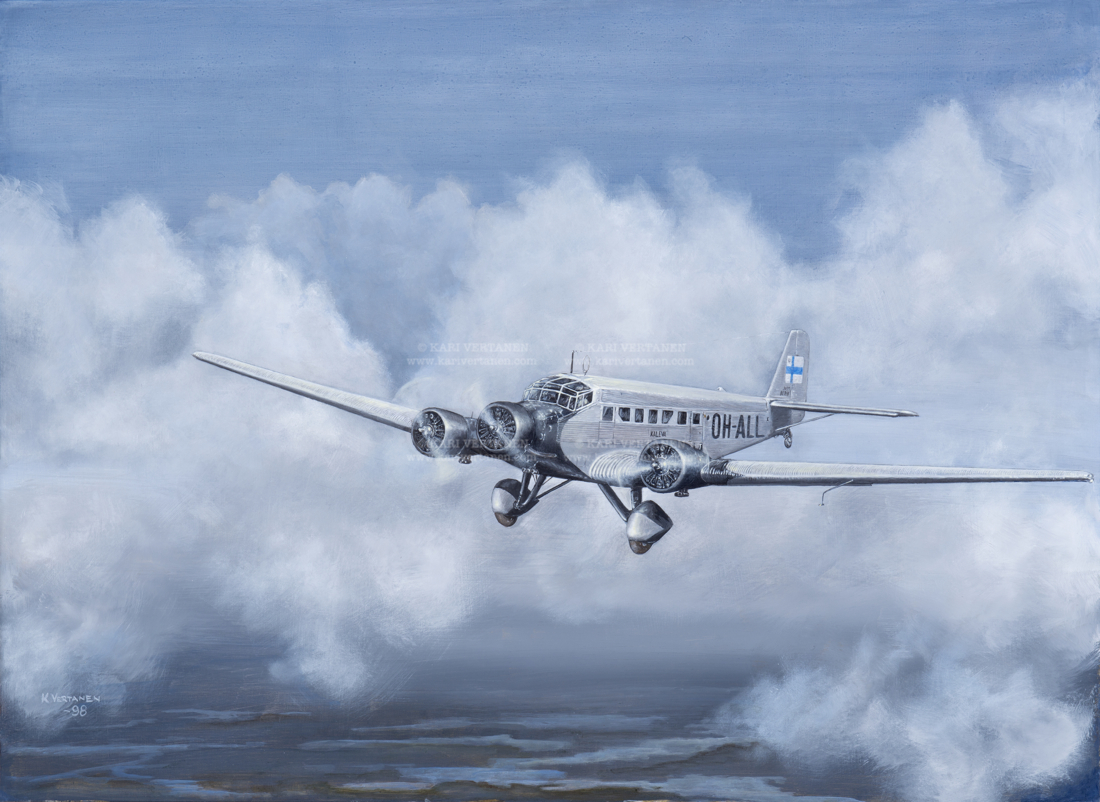
Kaleva, registered OH-ALL, was a civilian Junkers Ju 52
passenger and transport plane, belonging to the Finnish carrier Aero O/Y. The
aircraft was shot down by two Soviet Ilyushin DB-3 bombers during peacetime
between the Soviet Union and Finland on June 14, 1940, while en route from
Tallinn to Helsinki, killing all 9 on board.
A few minutes after taking off in Tallinn, Kaleva was joined
at close range by two Soviet DB-3T torpedo bombers. The bombers opened fire
with their machine guns and badly damaged Kaleva, making it crash into the
water a few kilometers northeast of Keri Lighthouse. All nine passengers and
crew members on board were killed.
Estonian fishermen had witnessed the attack and crash of the
plane. Shortly after the crash the Soviet submarine Shch-301 surfaced and
inspected the fishing boats. After confiscating items taken from the wreck by
the fishermen, the Soviets picked up diplomatic mail from the wreck and the
sea. The future top-scoring Finnish pilot Ilmari Juutilainen was sent to
inspect the crash site. After the Soviets spotted the Finnish airplane, the
submarine hid its flag.
At the time of the incident Finland was not at war with the
Soviet Union. The attack was probably part of the Soviet preparations for the
full-scale occupation of Estonia, which took place two days after the Kaleva
incident, on 16 June 1940. The occupation was preceded for several days by a
Soviet air and naval blockade, which included preventing diplomatic mail from
being sent abroad from Estonia. The passengers on the last flight of Kaleva
included two German businessmen, two French embassy couriers, one Swede, an
American courier, and an Estonian woman. The French couriers had over 120
kilograms of diplomatic mail in the plane. The American courier was reportedly
transporting the U.S. military codes to safety from Estonia.
The plane was piloted by Captain Bo von Willebrand, and
Tauno Launis was the wireless operator. The American victim was Henry W.
Antheil, Jr., younger brother of noted composer George Antheil. Antheil worked
as a clerk at the U.S. Legation in Helsinki. In 2007, he was honored for his
service in a ceremony at the U.S. Department of State. His name was inscribed
on the U.S. Department of State’s Wall of Honor.
The Government of Finland did not send any complaints or questions
to the Soviets out of fear of hostile Soviet response, and the true reason for
the crash was hidden from the public. This was due to the heavy pressure put
upon Finland during the Interim Peace by the Soviets. After the outbreak of the
Continuation War, the incident was described in detail by the government.
G. Golderg’s report
The commander of Shch-301 G. Golderg’s report on the
incident held in the Russian State Naval Archives starts with the notice of a
Finnish airplane on its way from Tallinn to Helsinki on June 14, 1940 at 15.05
PM. According to the report, the airplane was chased by two Soviet Tupolev SB
high-speed bombers. At 15.06 PM, the Finnish airplane caught fire and fell into
the sea, 5.8 miles from the submarine. At 15.09 PM the submarine took course to
the crash site and made it to the location by 15.47 PM. The submarine was met
by 3 Estonian fishing boats near the detritus of the airplane. The Estonian
fishermen were searched by lieutenants Aladzhanov, Krainov and Shevtshenko. All
valuables found from the fishermen and in the sea were brought on board of the
submarine: the items included about 100 kg. of diplomatic post, valuables and
foreign currencies. At 15.58 a Finnish fighter plane was noticed with the
course towards the submarine. The airplane made 3 circles above the site and
then flew towards Helsinki. The exact coordinates of the crash site were
determined to be at 59°47′1″N 25°01′6″E.
A. Matvejev’s report
Captain A. Matvejev’s report states that on board the
Shch-301 noticed an airplane crash on June 14, 1940 at 15.06 on 5.8 miles
distance from the submarine. At the crash site 3 Estonian fishing boats and the
remains of the airplane were found. At 15.58 PM a Finnish fighter plane made 3
circles above the crash site. By 16.10 PM all items found from the sea and from
the hands of the fishermen were brought on board the submarine. The items
included about 100 kg of diplomatic mail, and valuables and currencies
including: 1) 2 golden medals, 2) 2000 Finnish marks, 3) 10.000 Romanian leus,
4)13.500 French francs, 5) 100 Yugoslav dinars, 6) 90 Italian liras, 7) 75 US
dollars, 8) 521 Soviet rubles, 9) 10 Estonian kroons. All items were put on
board of patrol boat “Sneg” and sent to Kronstadt.